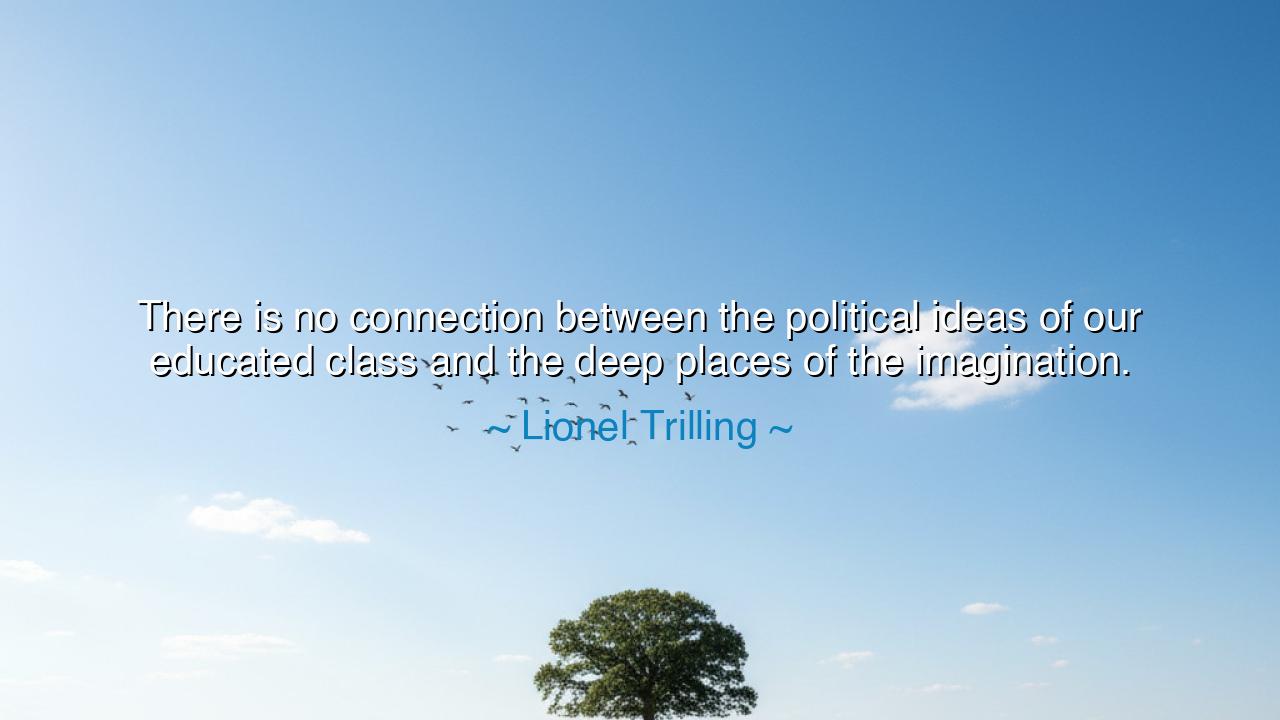
There is no connection between the political ideas of our
There is no connection between the political ideas of our educated class and the deep places of the imagination.






"There is no connection between the political ideas of our educated class and the deep places of the imagination." These words from Lionel Trilling call our attention to the growing divide between the intellectual elite and the rich, often untapped well of the imagination. Trilling suggests that those who occupy the higher echelons of society—those who shape political thought and wield intellectual power—often fail to connect with the deeper, more emotional and creative forces that guide human action. In other words, the educated class may craft systems, policies, and ideologies, but these ideas often lack the vibrancy and humanity that the imagination provides. The imagination, the very wellspring of creativity and deep human insight, seems to stand in opposition to the mechanical and often abstract nature of political thought.
In the ancient world, the relationship between reason and imagination was one of constant tension and balance. The Greeks revered both the philosopher and the poet, but they recognized that the two operated in fundamentally different realms. Plato, in his Republic, elevated the philosopher as the one who sought truth through logic and reason, but also understood that there was a deeper world that could not be grasped solely by reason—the world of the imagination and the arts. Aristotle sought to bring reason into the arts through his Poetics, yet even he acknowledged that the imagination could transcend the limits of rational thought, allowing the artist to capture the essence of the human spirit in ways that reason alone could not. The imagination, then, was seen as the domain of creativity, of truth that was not always immediately rational but deeply felt and experienced.
Consider the myth of Prometheus, the Titan who brought fire to humanity, an act that symbolized the giving of knowledge and creativity. In ancient Greece, Prometheus was viewed as a figure who bridged the gap between the gods and mortals, bringing not only fire but the gifts of art and craft. Yet, his punishment by Zeus—bound to a rock, where an eagle would eat his liver every day—was a reflection of the tension between imagination and control. Prometheus’s act was not purely rational; it was an act of defiance, of vision beyond the constraints of established order. Trilling’s quote echoes this sentiment: the political class often fails to see that their rational systems do not resonate with the deep, creative forces that drive true human growth. The imagination cannot be contained within the borders of political ideologies, no matter how educated the thinkers may be.
In modern times, we see this divide more clearly in the way political ideas often fail to capture the human experience in its entirety. Karl Marx, whose ideas greatly influenced political thought in the 19th and 20th centuries, approached society through a highly rational lens, focusing on the economic structures that governed human life. Yet, as revolutionary as his ideas were, they often overlooked the individual—the creative, imaginative spirit that drives personal transformation. Political movements that emphasize efficiency, class struggle, or material conditions tend to overlook the dreams and aspirations that transcend the material world. Trilling’s words reflect the gap between theory and human reality: political thought, while important, often struggles to address the deeper, more emotional forces that shape how people truly live and create.
This divide is also evident in the history of art and politics in the 20th century. The Russian Revolution, for instance, led to a new political order, yet its artistic expressions were often stifled by the demands of the state. The early enthusiasm for revolutionary art quickly gave way to a regime that sought to control creative expression, leading to the rise of socialist realism—art that was meant to serve the political ends of the state rather than the human spirit. Artists like Vasily Kandinsky and Marc Chagall, who had once been inspired by revolutionary ideals, were marginalized as their abstract, imaginative works did not align with the state’s rigid expectations. The clash between the political class and the imagination was evident in how the state sought to control creativity, missing the deeper emotional truths that art was meant to express.
What can we learn from Trilling’s insight? The lesson is clear: political ideas—though essential in structuring society—must not be divorced from the deeper forces of imagination, creativity, and emotion. These forces give life to the ideas we create. Without imagination, our systems of governance, our ideologies, and our plans risk becoming cold, mechanical, and detached from the true experience of humanity. As Plato understood, reason and imagination must work together to create a society that is not only rational but also compassionate, beautiful, and human.
In our own lives, we must strive to integrate reason and imagination, ensuring that our ideas are not only grounded in the practicalities of the world but also connected to the deeper truths of human experience. Whether in politics, art, or our daily actions, we must recognize that it is the imaginative spirit—the ability to dream, to envision, to feel—that shapes the soul of our societies. Let us therefore challenge ourselves and our leaders to look beyond the cold logic of policies and to embrace the human spirit in all its complexity. Only through the marriage of the mind and the imagination can we hope to create a world that reflects the true richness of human life.






AAdministratorAdministrator
Welcome, honored guests. Please leave a comment, we will respond soon